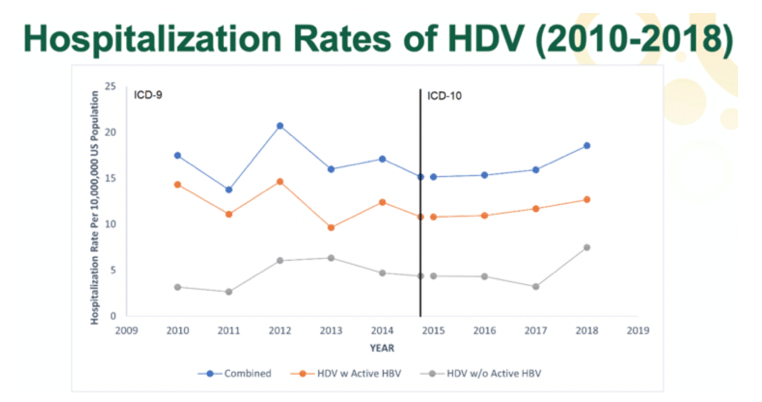 |
 |
 |
| |
HDV Hospital Admissions Rare-But Sometimes Severe-in United States
|
| |
| |
AASLD, The Liver Meeting, November 12-15, 2021
Mark Mascolini
Average annual hospital admissions with hepatitis D virus (HDV) infection in the United States fell from 16.7 per 10 million people in 2010-2015 to 7.4 per 10 million in 2015-2018, according to a nationwide database analysis [1]. But compared with people infected only with HBV, those with HDV had higher rates of liver failure, nonalcoholic cirrhosis, portal hypertension, ascites, and thrombocytopenia.
Researchers call HDV a satellite virus because it requires infection with HBV[2]. Among 292 million people with chronic HBV infection worldwide, between 4.5% and 14.6% also carry HDV [3,4]. A systematic review estimated that HDV accounts for 18% of cirrhosis and 20% of hepatocellular carcinoma in people with HBV [3]. But the burden of HDV remains poorly understood in the United States. With bulevirtide licensed for treatment of HDV infection in Europe and approval anticipated in the United States, getting a better fix on HDV hospital admission rates, morbidity, and mortality in the United States gained urgency.
The analysis used data from the 2010-2018 National Inpatient Sample from the Healthcare Cost and Utilization Project. Researchers from the University of Florida College of Medicine used ICD-9 and -10 codes to identify all hospital admissions with HDV plus admissions with HBV without HDV and to gather demographic, geographic, and clinical data.
Among people admitted to the hospital with HBV infection, 0.6% had HDV (author said this suggests HDV is underdiagnosed in USA). Annual hospital admission rate with HDV averaged 16.7 per 10 million people in 2010-2015 then fell by more than half to 7.4 per 10 million in 2015-2018. Hospital admission rates of HDV without active HBV and HDV with active HBV both trended upward from 2015 through 2018. Combined HDV hospitalization rates (with or without HBV) stood around 20 per 10 million US people from 2010 through 2018. In contrast hospital admission rates with HBV infection stayed around 2500 per 10 million US people across that study period.
Compared with the 413,355 hospital admissions for HBV alone, the 3035 admissions for HDV included a significantly higher proportion of men than women (66.3% vs 61.3%, P = 0.012). Median age stood at 53 years in both the HDV group and the HBV-only group. The HDV and HBV-only contingents included a similar proportions of whites (43.1% and 41.6%), and the HDV group had a slightly lower proportion of blacks (22.8% and 26.3%), while the proportion of Hispanics measured 14.5% in the HDV group versus 8.4% in the HBV-only group (P < 0.001).
Hospitals in the Northeast accounted for 41% of HDV admissions compared with 25% of HBV-only admissions. In contrast the South absorbed 27% of admissions for HDV and 38% for HBV alone. Western states admitted 20% of HDV cases and 21% of HBV-only cases. And the Midwest admitted 12% of HDV cases and 16% of HBV-only cases.
Compared with people admitted to the hospital for HBV alone, those admitted for HDV had significantly higher rates of liver failure (6.5% vs 4.5%, P = 0.018), nonalcoholic cirrhosis (20.5% vs 15.2%, P < 0.001), portal hypertension (12.9% vs 6.8%, P < 0.001), ascites (16.5% vs 10.8%, P < 0.001), and thrombocytopenia (22.0% vs 18.0%, P = 0.012). But overall mortality in the HDV group mirrored that in the HBV-only group at 3.7%. In the HDV group logistic regression identified two predictors of mortality-being 65 or older (odds ratio 3.79, P = 0.020) and an alcoholic cirrhosis diagnosis (odds ratio 3.37, P = 0.044).
The AASLD recommends testing HBsAg-positive people for anti-HDV antibodies if they belong to certain HDV risk groups: people with HIV infection, drug injectors, men who have sex with men, and immigrants from areas with high HDV endemicity. EASL recommends anti-HDV antibody testing in everyone positive for HBsAg regardless of other risk factors.
The researchers concluded that hospital admission for HDV infection is rare in the United States but fraught with risk of severe complications. They argued that "there is reason to screen all HBV+ for HDV" considering the increased complications of HDV and the recent developments in HDV treatment - early HDV detection through routine testing of everyone with HBV could "slow disease progression and avoid severe outcomes as HDV-specific treatments are emerging."

References
1. Wasuwanich P, et al. Hepatitis D-associated hospitalizations in the United States: 2010-2018. AASLD, The Liver Meeting, November 12-15, 2021. Abstract 225.
2. Polaris Observatory Collaborators. Global prevalence, treatment, and prevention of hepatitis B virus infection in 2016: a modelling study. Lancet Gastroenterol Hepatol. 2018;3:383-403. doi: 10.1016/S2468-1253(18)30056-6.
3. Stockdale AJ, Kreuels B, Henrion MYR, et al. The global prevalence of hepatitis D virus infection: Systematic review and meta-analysis. J Hepatol. 2020;73:523-532. doi: 10.1016/j.jhep.2020.04.008.
4. Chen HY, Shen DT, Ji DZ, et al. Prevalence and burden of hepatitis D virus infection in the global population: a systematic review and meta-analysis. Gut. 2019;68:512-521. doi: 10.1136/gutjnl-2018-316601.
|
| |
|
 |
 |
|
|